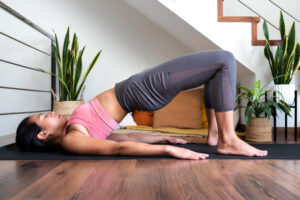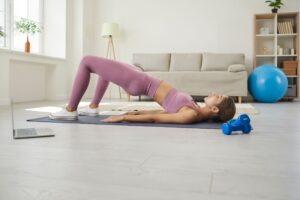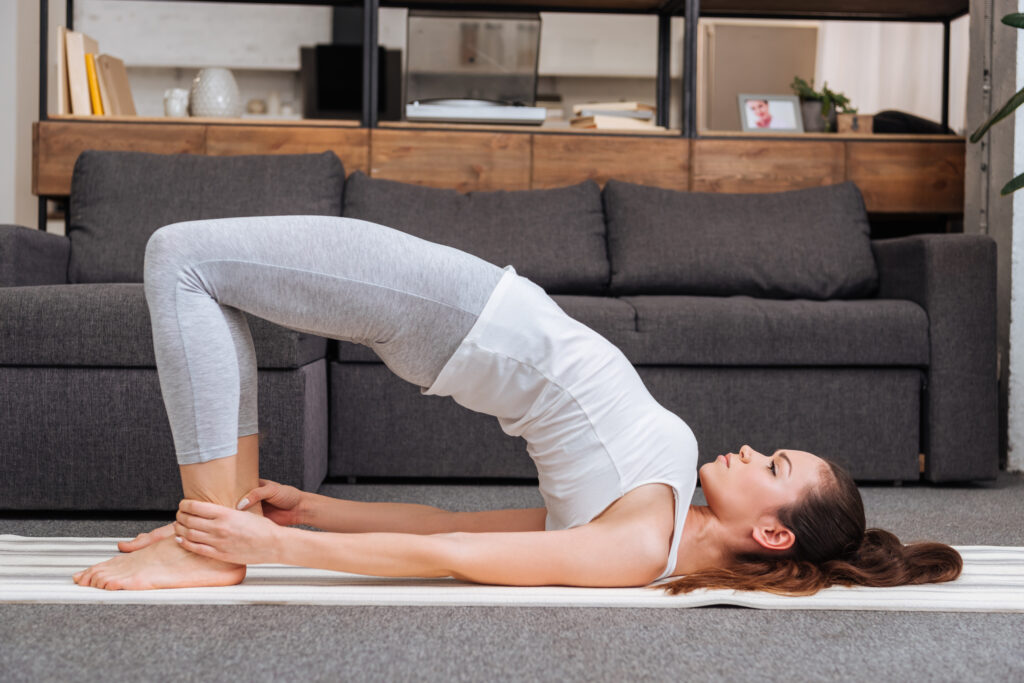Yoga’s fundamental pose, known by its Sanskrit name Setu Bandhasana, is the bridge pose, which has been practiced for centuries.
With your knees bent and your feet flat on the floor, you should be lying on your back in this stance. By raising your hips toward the ceiling, you engage and strengthen your thighs, buttocks, and back by forming the shape of a bridge with your body.
Although frequently used as a warm-up or preparatory pose for more difficult backbends, the bridge pose has more potential. It provides various benefits to the body and mind and is a popular choice for yoga practitioners at all levels. In the following sections, we will explore the benefits of bridge pose and how to integrate it into your daily yoga practice.
Table of Contents
ToggleHow to do Bridge Pose
- Lie on the back. Bend your knees.
- Spread your legs with your feet flat on the ground.
- Stretch your arms out to each side of your body to touch the back of the heels
- Gently raise your hips up
- Tuck your chin in slightly toward your chest which helps to lengthen the back of your neck.
- Put your hands under the back in an interlace
- Engage your inner thighs and relax your glutes.
- Hold for 30 seconds.
Physical Benefits of Bridge Pose

The following are some of the main advantages of consistently practicing this pose:
Strengthens the back, buttocks, and thighs
The bridge pose grips and strengthens the muscles in your back, buttocks, and thighs as you raise your hips off the floor. This can aid with general stability, posture, and lower back pain relief. It is also beneficial for energizing worn-out and weak legs.
Improves flexibility
The bridge posture improves flexibility by stretching the spine, chest, and neck. Additionally, it releases tension in the quadriceps and hip flexors, which is very helpful for individuals with tight hip muscles or who spend a lot of time sitting down.
Boosts blood circulation
The heart is placed higher over the head in the bridge pose, creating a natural inversion. The inversion increases oxygen flow towards the brain and the upper body, thereby increasing oxygenation and circulation of cells.
Improves metabolism and digestion
The liver, kidneys, and other abdominal organs are stimulated in the bridge pose. The posture massages the abdominal organs, such as the stomach and colon (the lower portion of the intestine), which enhances metabolism, excretion, and digestion and improves overall gut health.
Cultivates balance
Firm connections between the lower body and core are necessary for the bridge position, which enhances stability and balance. A routine practice can improve body awareness and sense of balance.
Soothes Pain
The bridge pose requires a strong connection between the core and lower body, which helps improve balance and stability. Regular practice of this pose can enhance proprioception and body awareness.
Relieves Asthma and Sinusitis
Widening the chest in the pose aids in enhancing lung capacity even further, which lessens symptoms of asthma. Additionally, enabling blood flow to the head helps relieve sinusitis.
Corrects Tennis Elbow
Tennis players are frequently affected with tennis elbow, a disorder where repetitive arm and wrist motion can cause pain and restricted elbow movement. In this case, bridge pose can help with elbow pain relief.
This could result from the elbow muscles being stretched during this exercise as you press down on the floor or elevate your back while gripping your ankles.
Beneficial for thyroid
Bridge pose provides a sufficient neck stretch, which helps maintain and control thyroid gland activity and, as a result, contributes to increased thyroxine production.
Mental Benefits of Bridge Pose
The mild inversion enables blood circulation to the head and relieves tightness in the shoulders and neck. As a result, the bridge pose aids in lessening headaches, anxiety, low mood, and stress. It also provides synchronization of the mind and body, which helps to stabilize and calm the nervous system.
Tips to Maximize the Benefits of Bridge Pose

Practice consistently: Practice two or three rounds of the bridge post repeatedly. With each time, one can raise their hips and bend the back more.
Firmly grasp the feet: Depending on how firmly an individual presses into the soles of their feet, they can raise their hips higher.
Deep breathing: Deep breathing during this pose is essential to achieve a relaxed state and to hold the pose long enough to reap the benefits of its deep stretch. Breathe in and out slowly and mindfully.
Let your glutes relax: Lift your hips with the support of your leg muscles and allow your glutes to loosen up.
Precautions For Bridge Pose
Avoid boat pose if you are pregnant or experiencing vertigo or elevated blood pressure. If you have carpal tunnel syndrome, place your wrists in a neutral position in this pose.
Individuals with neck or shoulder injuries must practice this pose with modifications and adjustments. In severe cases, practicing this posture under the instructor’s guidance is advised.

